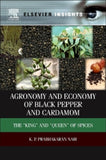Qualitative Analysis of Flavor and Fragrance Volatiles by Glass Capillary Gas Chromatography By Walter Jennings
Rare Book ! Second Hand Copy - Good Condition
Qualitative Analysis of Flavor and Fragrance Volatiles by Glass Capillary Gas Chromatography
Author(s):
Walter Jennings
Shibamoto
Qualitative Analysis of Flavor and Fragrance Volatiles by Glass Capillary Gas Chromatography deals with the application of glass capillary gas chromatography to qualitative analysis of flavor and fragrance volatiles.
Topics range from gas chromatographic system requirements and retention indices to selective detectors, ancillary reactions, and gas chromatography-mass spectrometry.
This text is comprised of six chapters; the first of which provides an overview of the use of glass capillary gas chromatography in qualitative analysis of flavor and fragrance volatiles. The discussion then turns to gas chromatographic system requirements with respect to columns, inlets, detectors, and temperature control. The reader is also introduced to the Kovats retention index system, which utilizes a logarithmic scale to describe the retention behavior of a compound relative to that of the n-paraffin hydrocarbons. The use of selective detectors, such as thermal conductivity, flame ionization, nitrogen-phosphorus, electron capture, and photoionization detectors in qualitative analysis, is also considered.
The final two chapters focus on ancillary reactions in glass capillary gas chromatography and general considerations in gas chromatography-mass spectrometry, including interfacing.
This book is intended primarily for researchers involved in studies of the volatile constituents of fragrances, food, and natural products.
Table of Contents
| Front Cover | 1 |
| Qualitative Analysis of Flavor and Fragrance Volatiles by Glass Capillary Gas Chromatography | 4 |
| Copyright Page | 5 |
| Table of Contents | 6 |
| Preface | 8 |
| PART A: ANALYTICAL CONSIDERATIONS | 10 |
|
Chapter I. Introduction |
10 |
|
Chapter II. Gas Chromatographic System Requirements |
11 |
| A. Columns | 11 |
| B. Inlets | 14 |
| C. Detectors | 17 |
| D. Temperature Control | 17 |
|
Chapter III. Retention Indices |
18 |
| A. General Considerations | 18 |
| B. Determination of Holdup Time tM | 18 |
| C. Effect of Liquid Phase and Surface Pretreatment | 18 |
| D. Effect of Temperature | 19 |
| E. Isothermal Procedures | 19 |
| F. Programmed Temperature Procedures | 20 |
|
Chapter IV. Selective Detectors |
20 |
| A. General Considerations | 20 |
| B. Thermal-Conductivity Detector | 22 |
| C. Flame-Ionization Detector | 22 |
| D. Nitrogen–Phosphorus Detector | 22 |
| E. Electron-Capture Detector | 23 |
| F. Flame-Photometric Detector | 23 |
| G. Photoionization Detector | 23 |
|
Chapter V. Ancillary Reactions |
24 |
| A. General Considerations | 24 |
| B. External Reactions | 24 |
| C. Reaction Gas Chromatography | 27 |
|
Chapter VI. Gas Chromatography–Mass Spectrometry |
31 |
| A. General Considerations | 31 |
| B. Interfacing | 32 |
|
PART B: APPENDICES |
38 |
| Appendix I Compounds and Their Retention Indices | 38 |
| Appendix II Retention Indices in Increasing Order on Methyl Silicone OV 101 | 67 |
| Appendix III Retention Indices in Increasing Order on Polyethylene Glycol Carbowax 20M | 95 |
| Appendix IV Mass Spectra of Individual Compounds | 123 |
| Index |


















